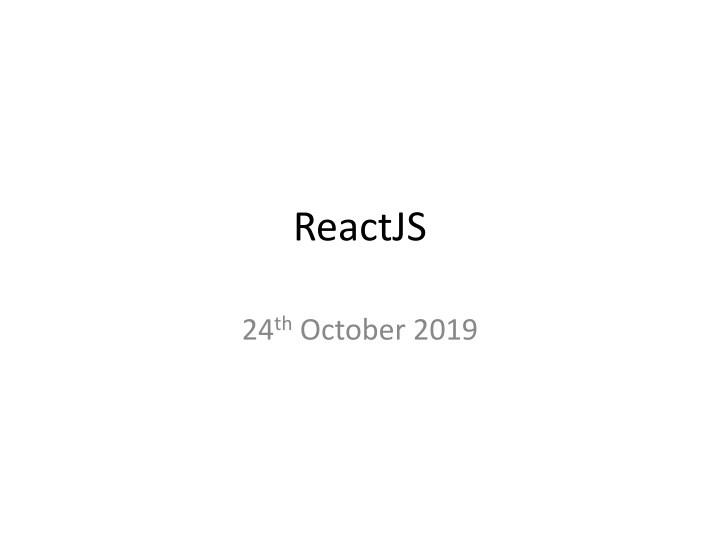
Understanding ReactJS: Key Concepts and Best Practices
Explore the key concepts of ReactJS, such as Virtual DOM and component-based logic. Learn about the importance of properties and states in React development, and discover why React is optimal for updating page components individually. Dive into the world of front-end frameworks and server architectures to enhance your coding skills.
Download Presentation

Please find below an Image/Link to download the presentation.
The content on the website is provided AS IS for your information and personal use only. It may not be sold, licensed, or shared on other websites without obtaining consent from the author. If you encounter any issues during the download, it is possible that the publisher has removed the file from their server.
You are allowed to download the files provided on this website for personal or commercial use, subject to the condition that they are used lawfully. All files are the property of their respective owners.
The content on the website is provided AS IS for your information and personal use only. It may not be sold, licensed, or shared on other websites without obtaining consent from the author.
E N D
Presentation Transcript
ReactJS 24thOctober 2019
Front-end frameworks Express is a back end framework for server- side JS scripting Brings in useful abstractions to simplify programming common server-side actions There are also front-end frameworks for client-side JS scripting Bring in useful abstractions to simplify programming common client-side actions
Server architectures Thin server All data processing shifted to client Thick stateful server Server processes data and sends desired changes to client Server maintains a record of the state of the client s page Thick stateless server Server processes data and sends desired changes to client Server doesn t maintain a record of the client s page
Which framework to use? Frameworks should not be used to cover up unfamiliarity with JS language
ReactJS Developed by FB Initial release 2013 Caught on with developers strongly in the past couple of years Optimal for updating page components individually
Key concepts Virtual DOM React creates an in-memory cache of the DOM Updates the displayed DOM efficiently Developer can write code assuming the whole page will change React will update only components that actually change Components are the basic unit of React logic
Properties Attributes are passed to components as a single object, called props Props are read-only within the component that defines them Need not be data, can also be functions
States The state is the default object that is loaded when a component is mounted on the DOM Values can change over time, based on user events Components manage their own state
props vs. states props state Can get initial value from parent component Yes Yes Can be changed by parent component Yes No Can set default values inside component Yes Yes Can change inside component No Yes Can set initial value for child components Yes Yes Can change in child components Yes No
Building an app with React Server has sent us a big JSON object to play around with (thin server) Step 1: Draw a mock-up of what the app should display https://reactjs.org/docs/thinking-in-react.html
Mapping front-end to back-end Step 2: Match UI to components FiliterableProductTable (orange) SearchBar (blue) ProductTable(green) ProductCategoryRow(tu rquoise) ProductRow (red)
Identify component hierarchy Build a static app to render all components, given data passed to FilterableProductTable in props
What should be the application state? For each datum in our app, ask Is it passed to this component from a parent? Does it change over time? Can it be computed from some other state or props? If no on all counts, it s a state In our example Search box text Checkbox value
Data flow Place the state as high in the hierarchy as possible Now app will display correctly based on state Write callbacks to searchBar from filterableProductTable to fire whenever its inputs are updated You have two-way data flow now
Next week in lab Follow the tic-tac-toe React tutorial Make it work for a 4x4 grid Hopefully, you have your NodeJS app hooked up to a database by now If not, please ensure this is so by end of the coming week
JavaScript app assignment (updated) Supersedes earlier announcement I said MEAN, but it can be MERN, CMAN, or any other stack, so long as its built on NodeJS at the back end Must demo by 13th November Project specs Mobile front-end (15% credit) Should read and write to a database (10% credit) Should perform at least two front-end view manipulations without pulling from the server (15% credit) Should use at least on native mobile function (10% credit) Should have secure login management, fine to use Passport (15% credit) Database should be secured separately (10% credit) Should protect against XSS attacks Project complexity and implementation competence (25% credit)
